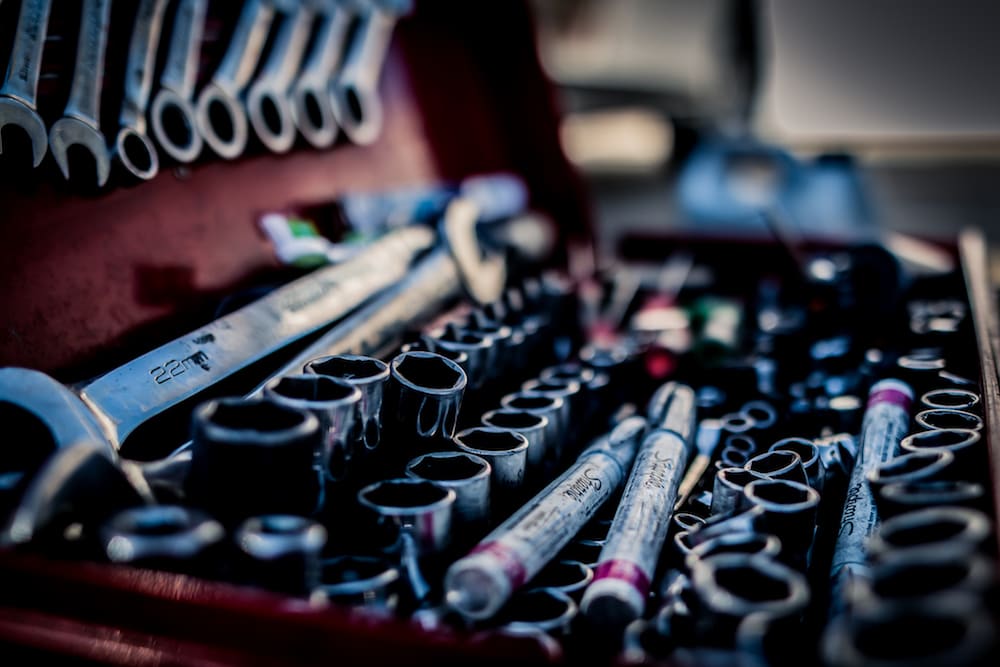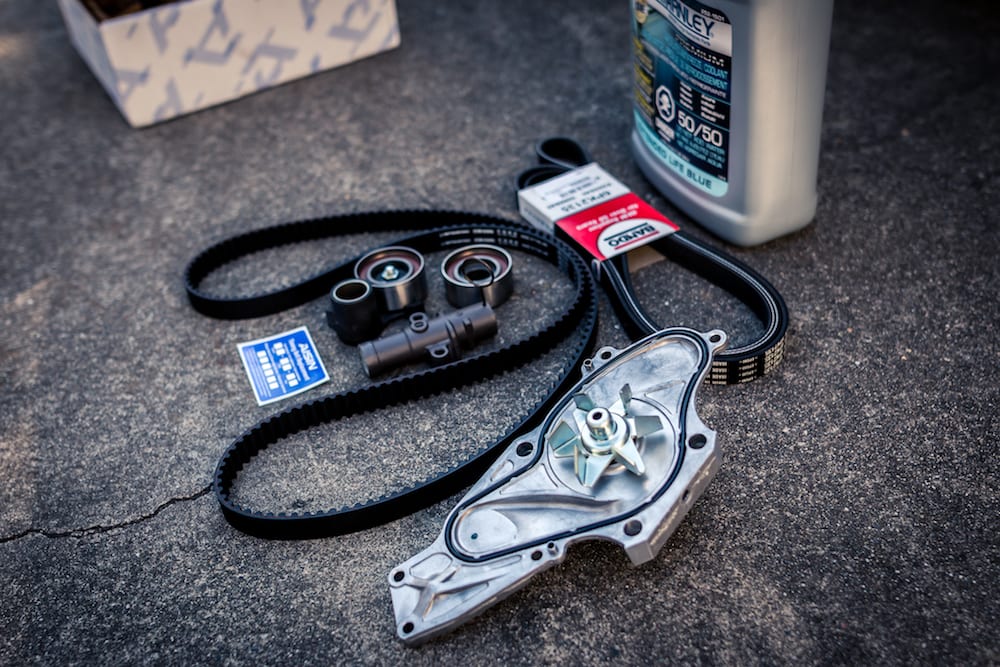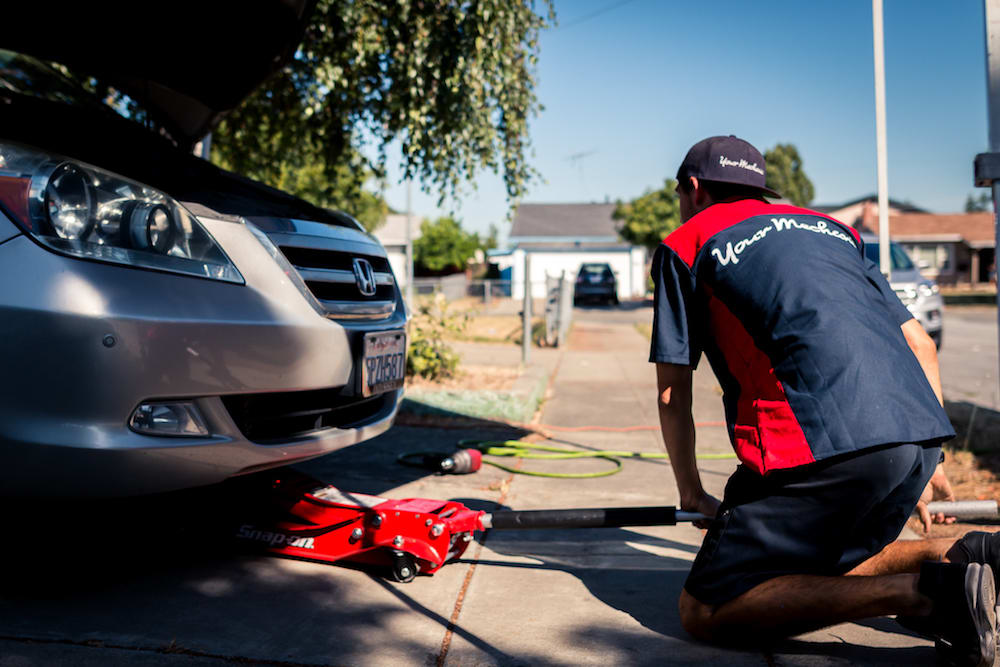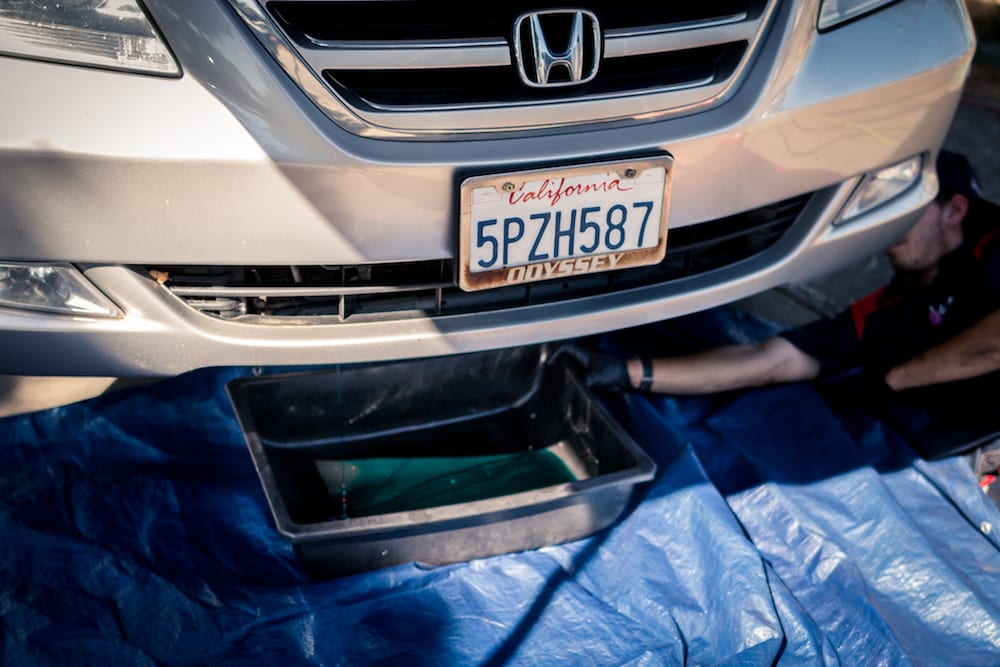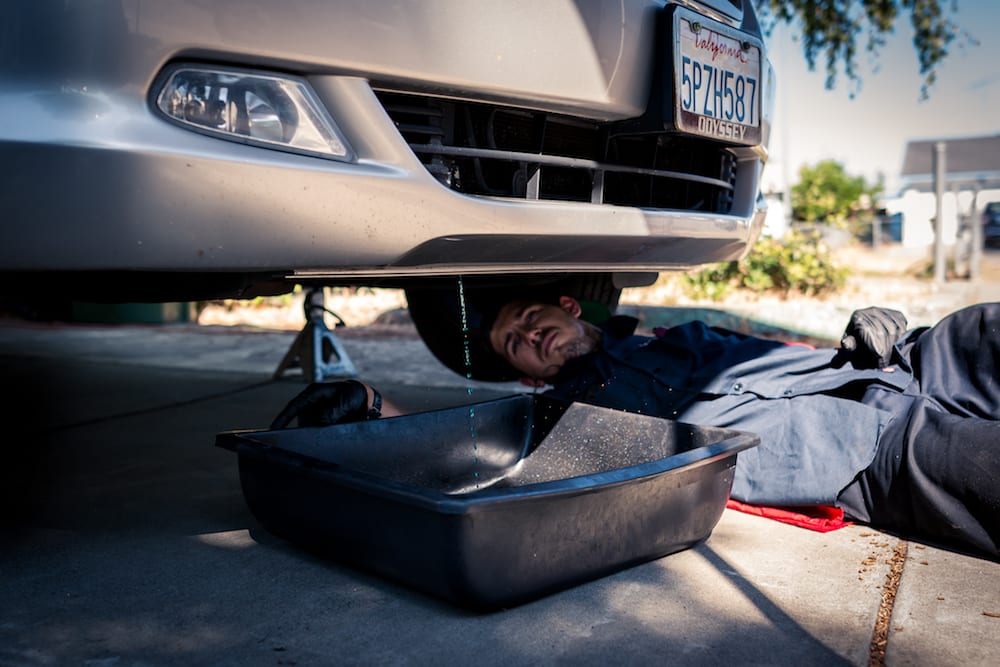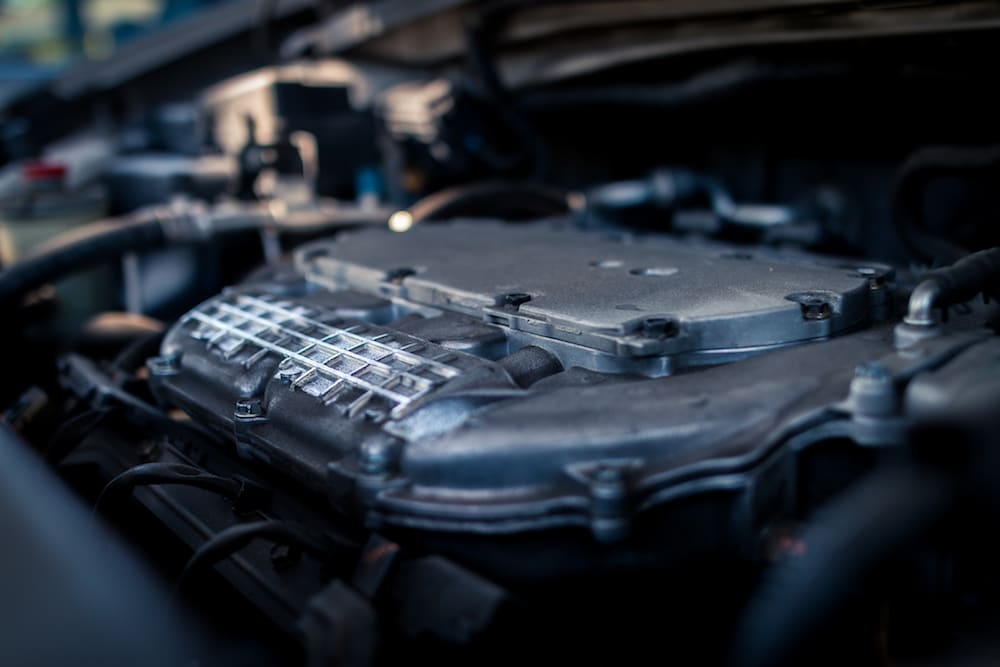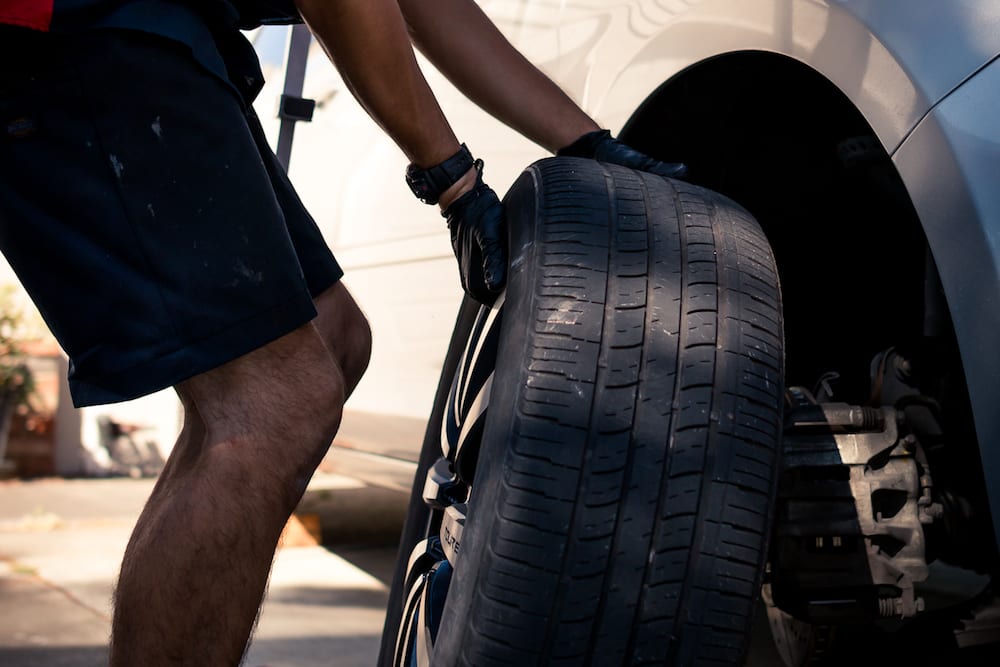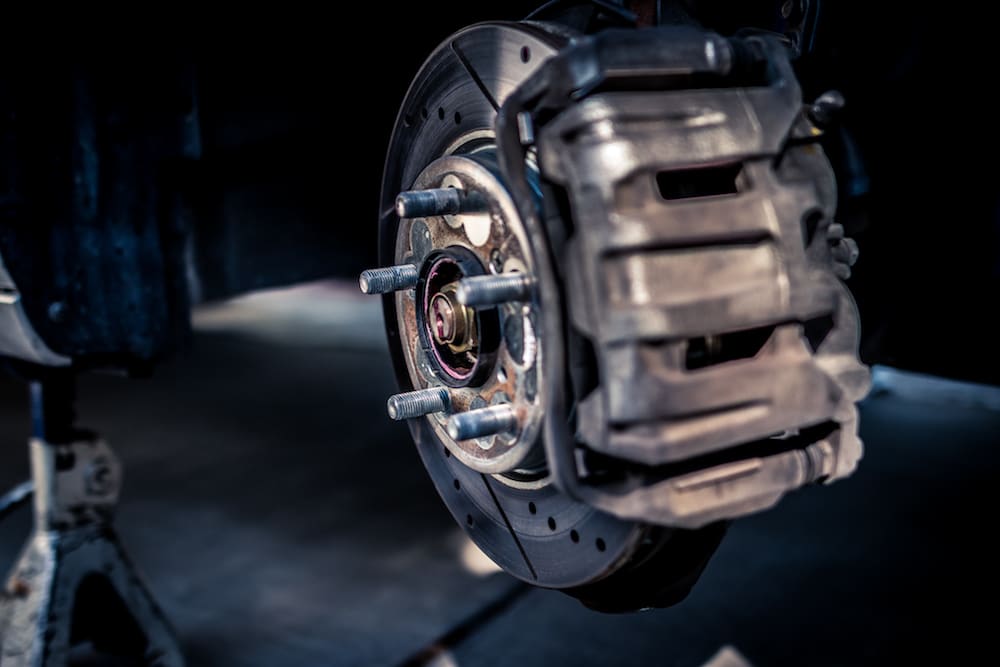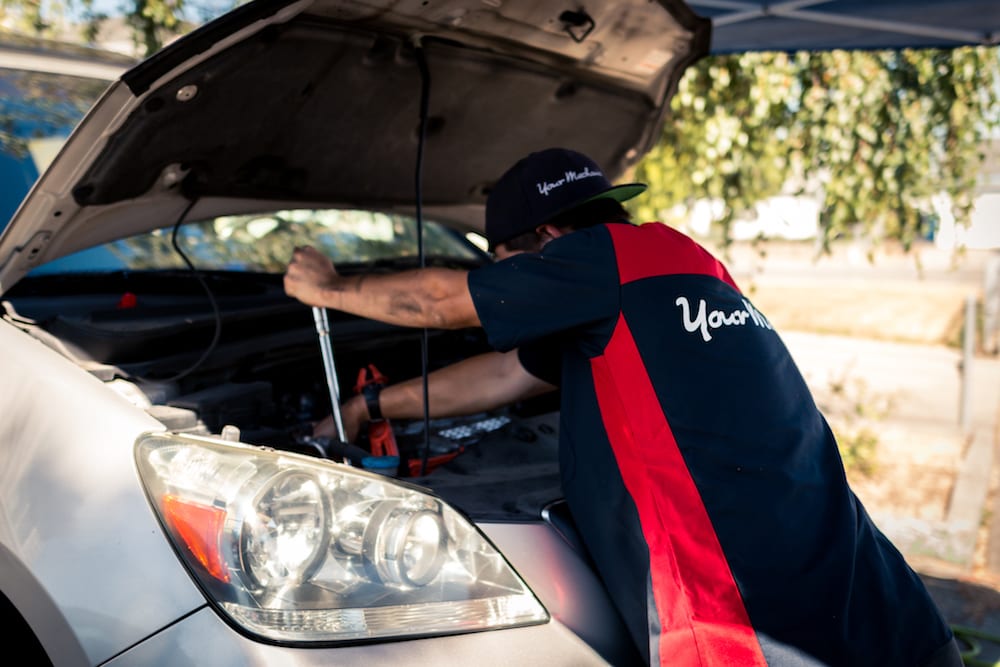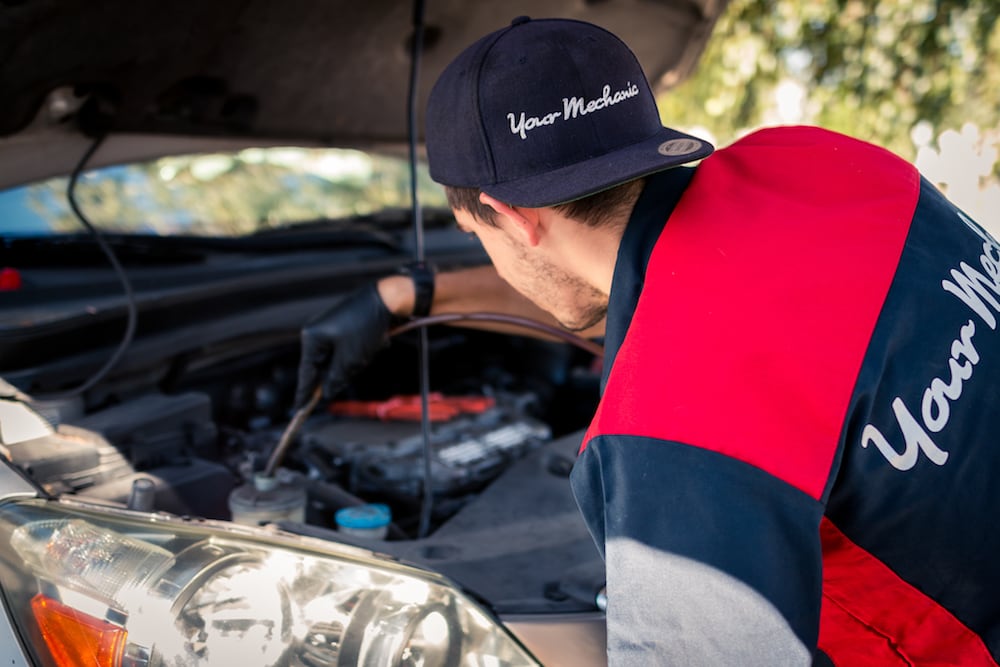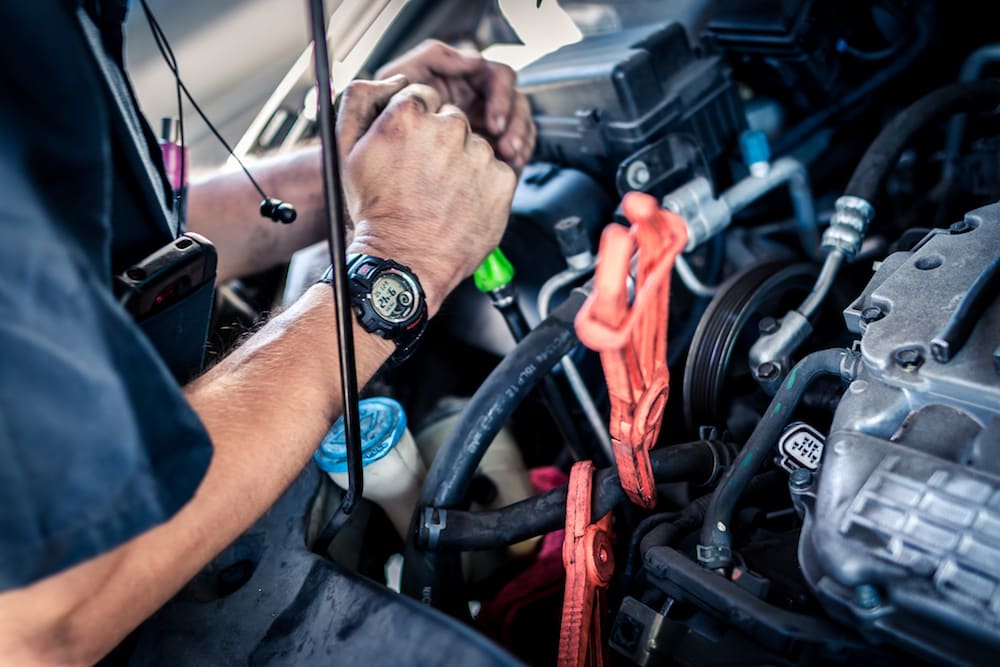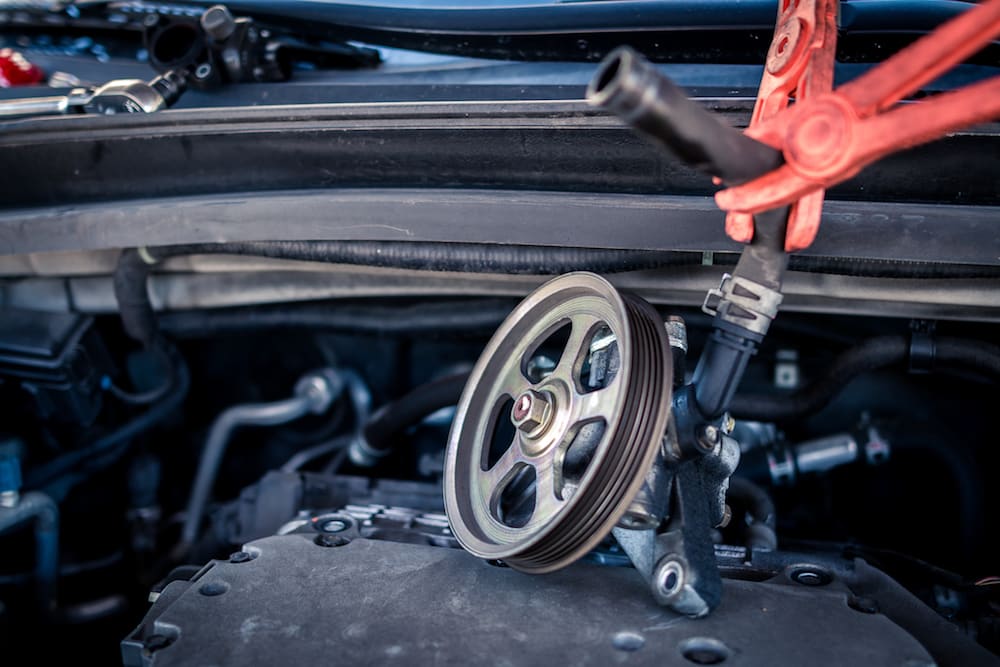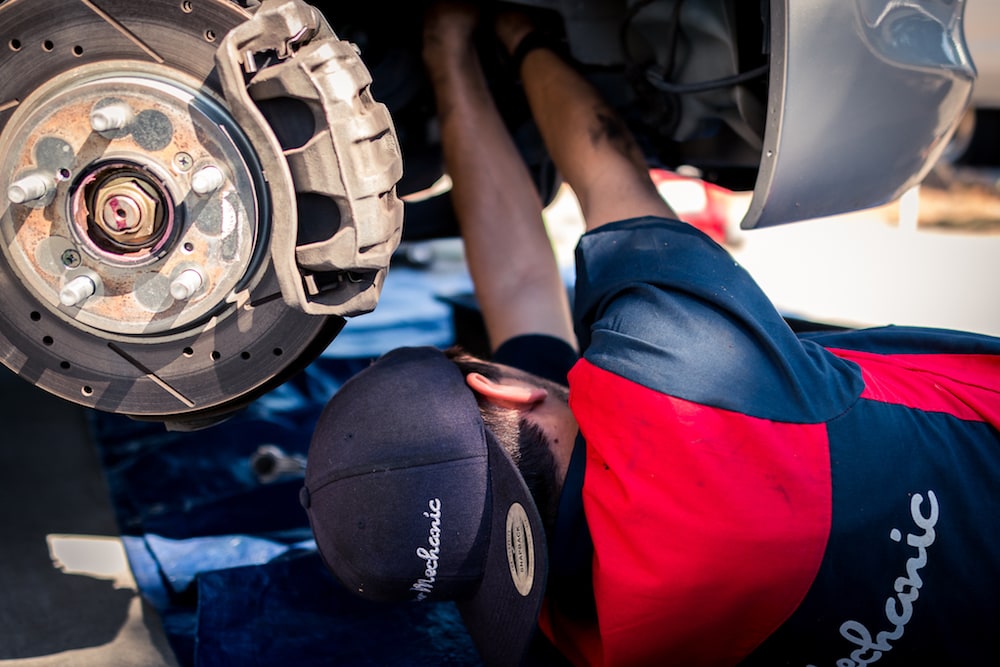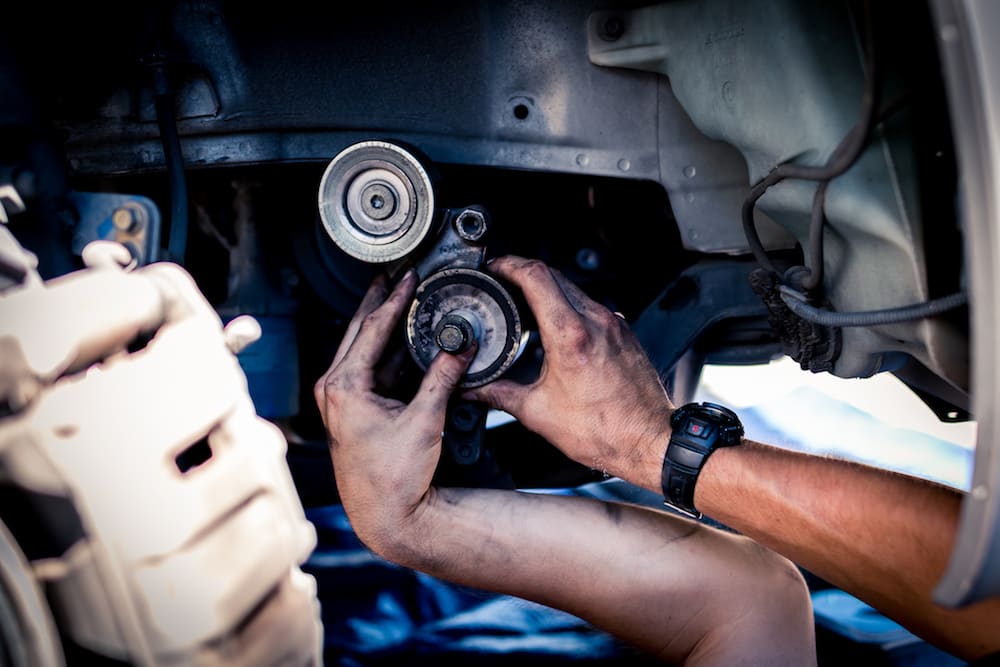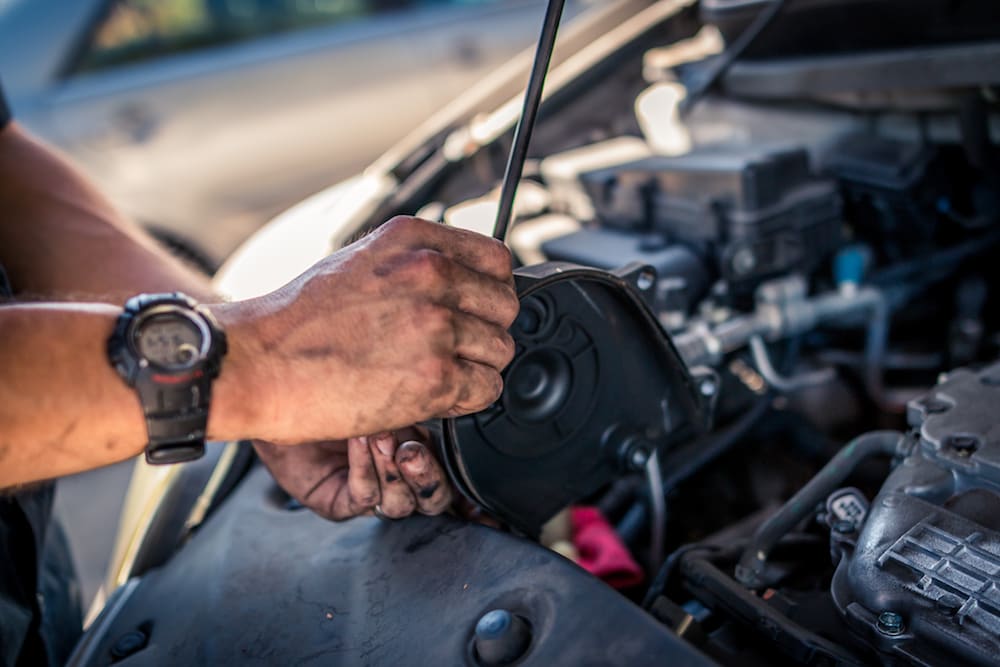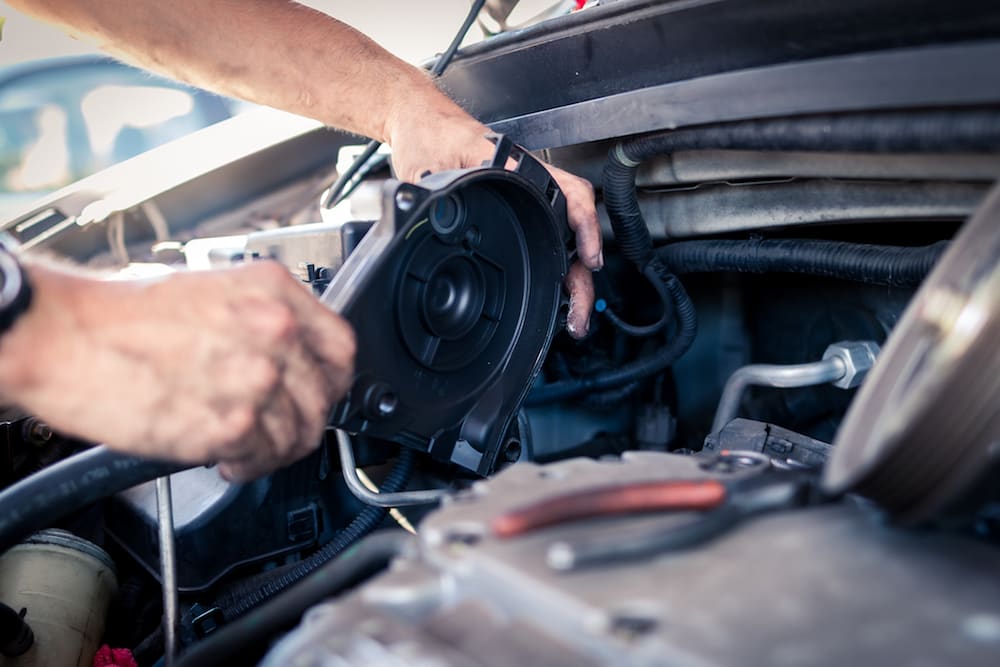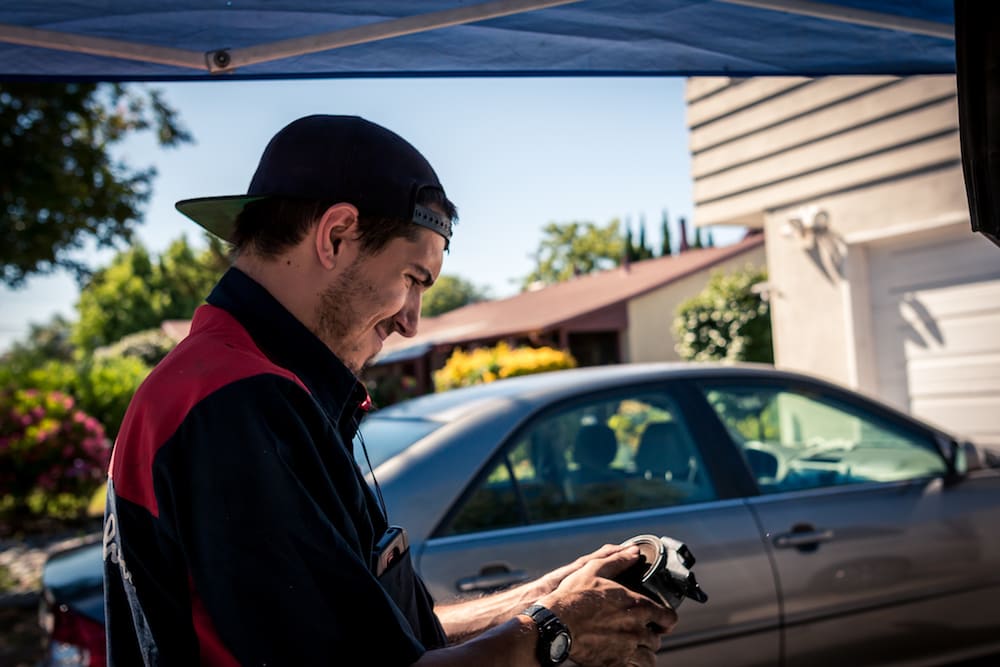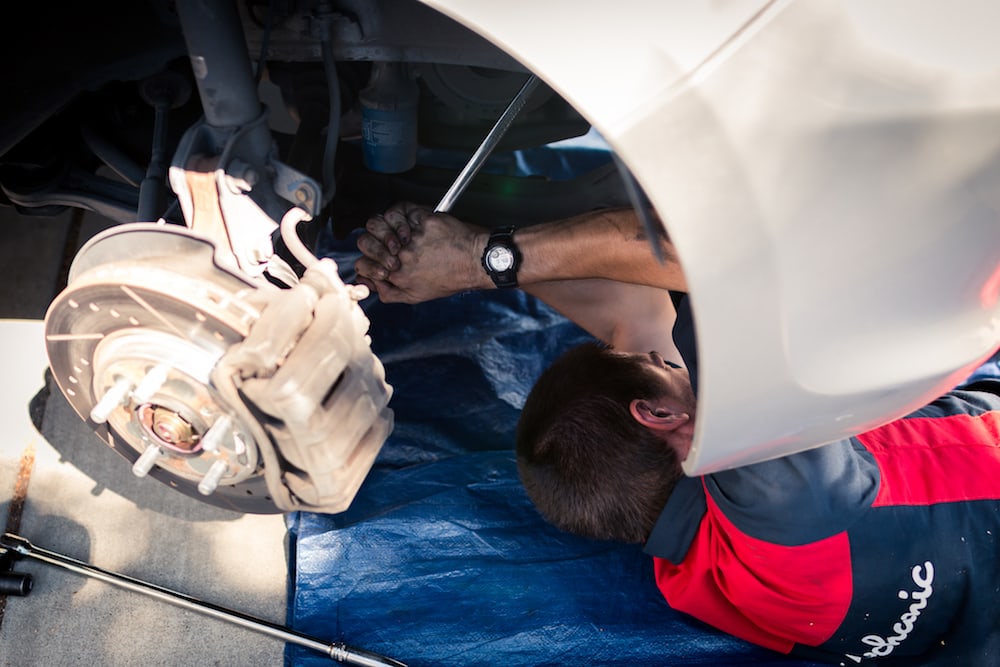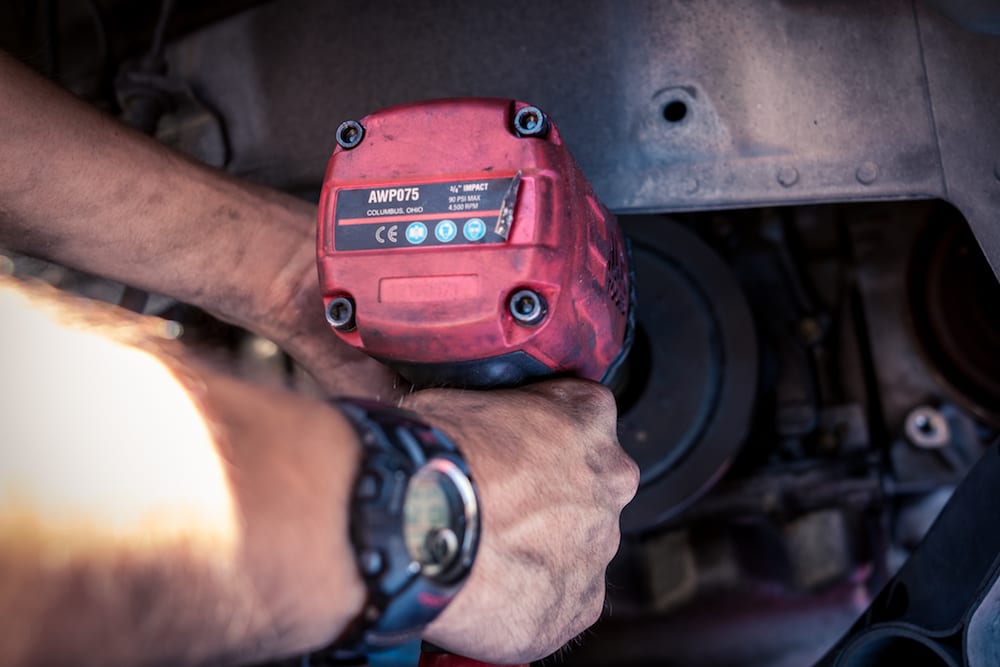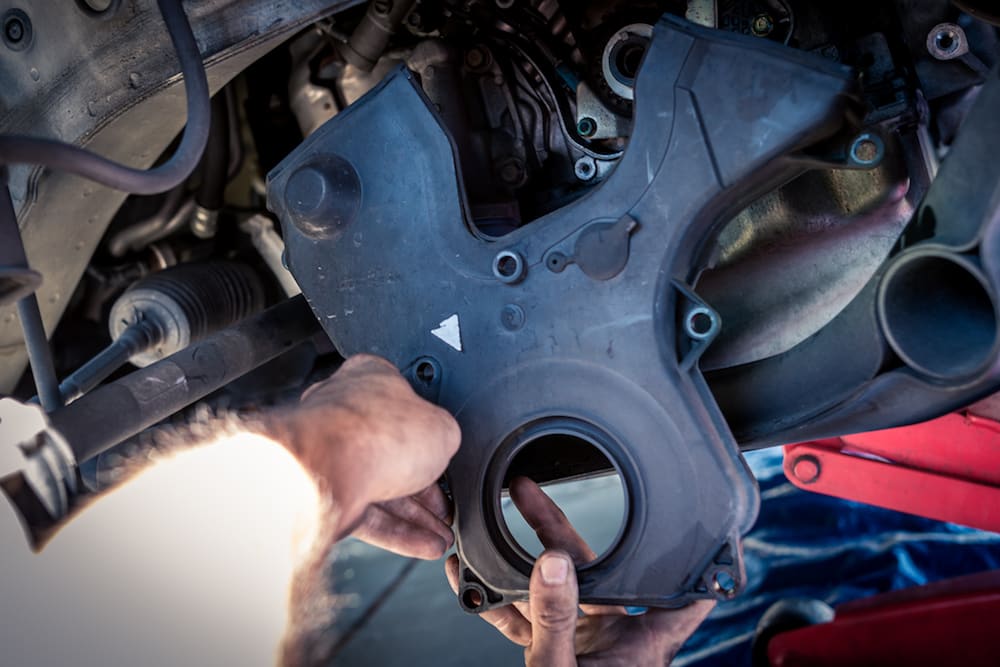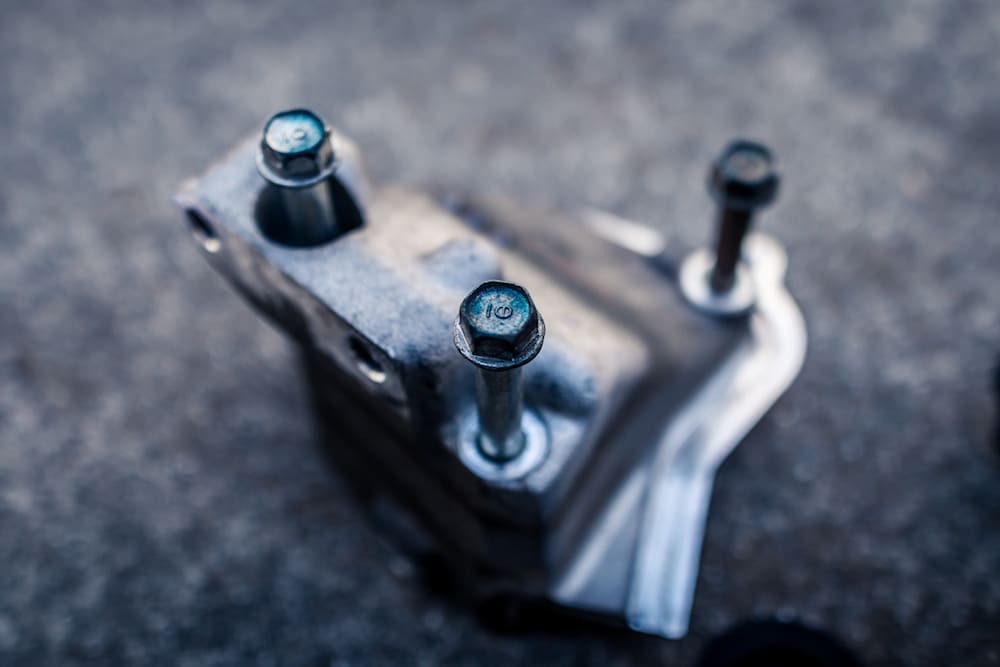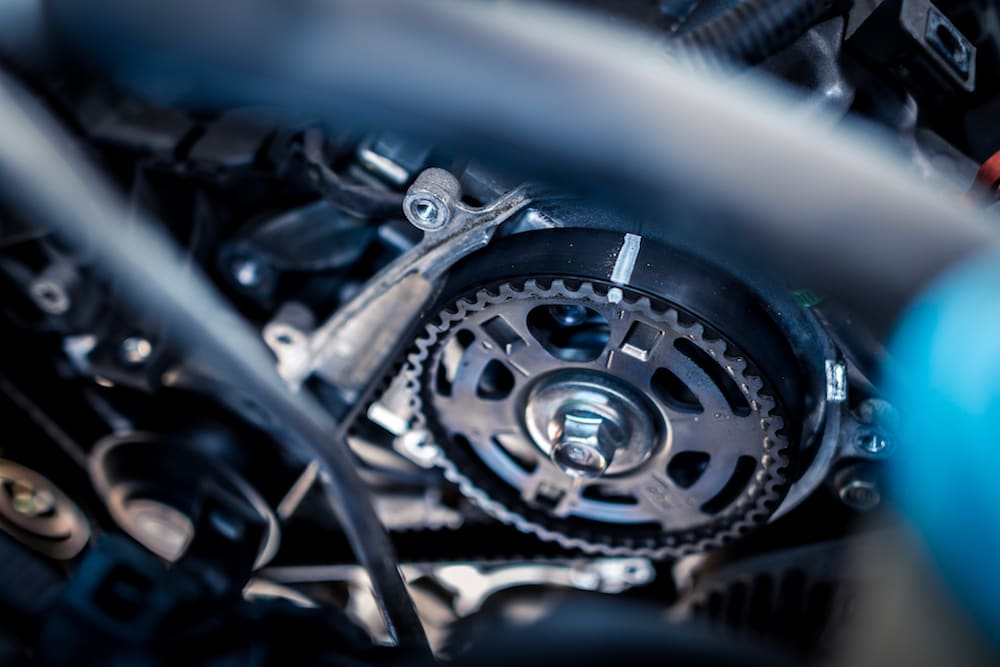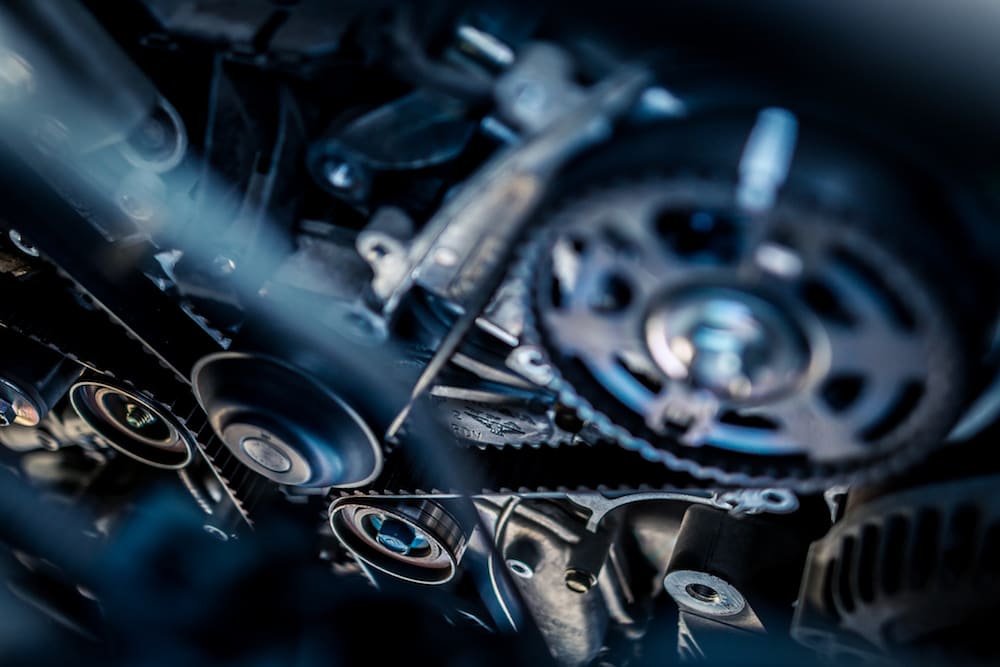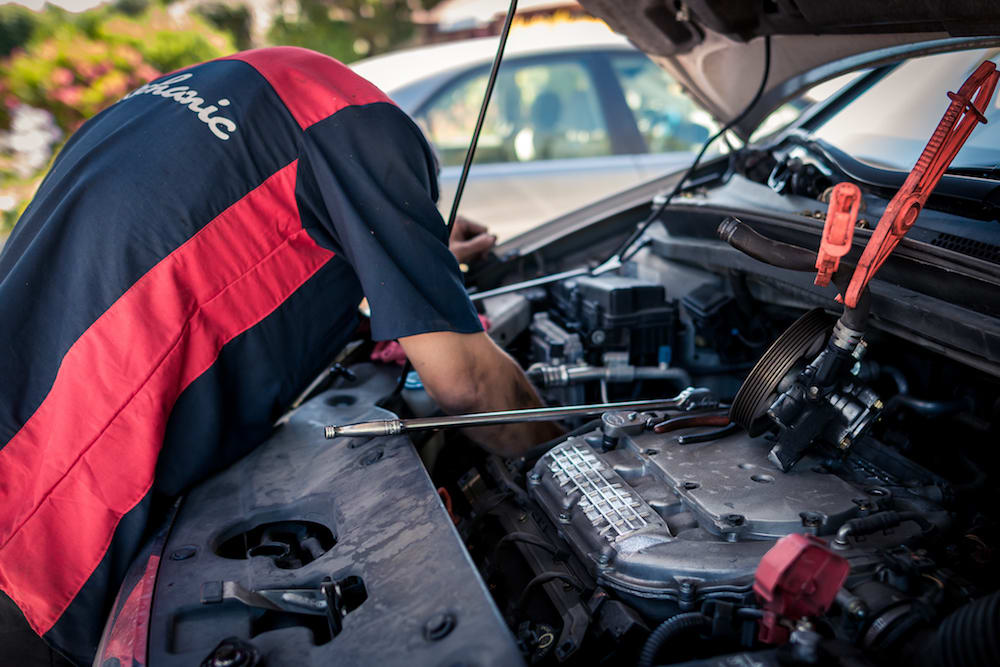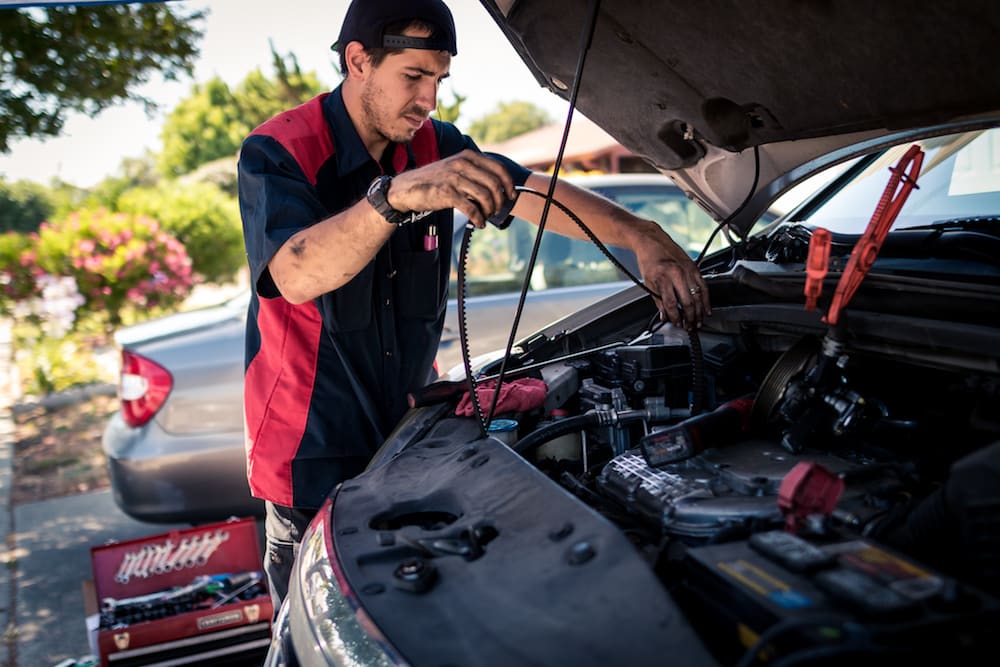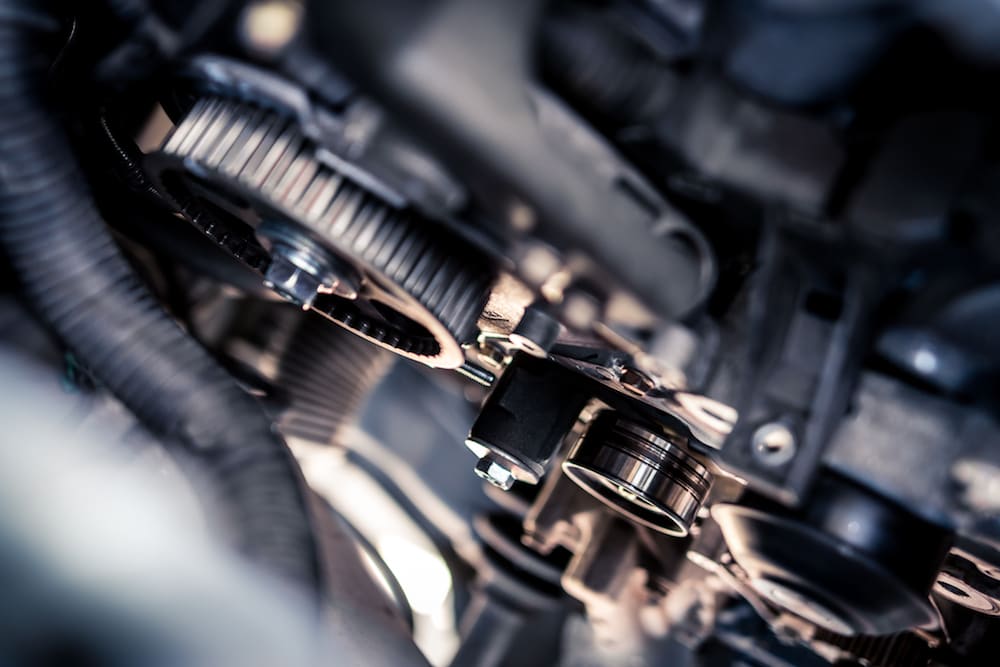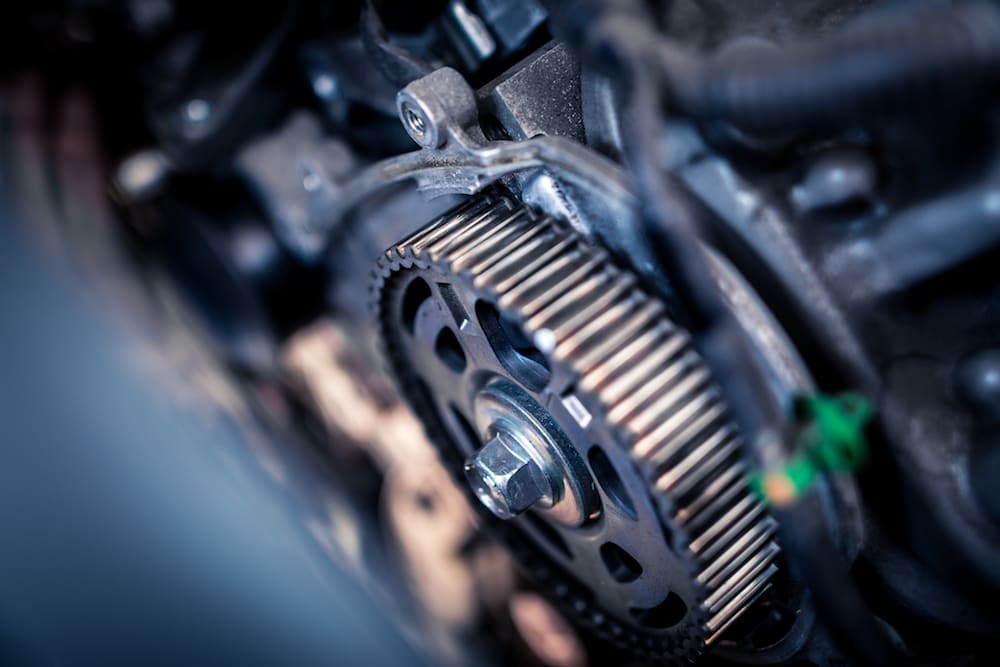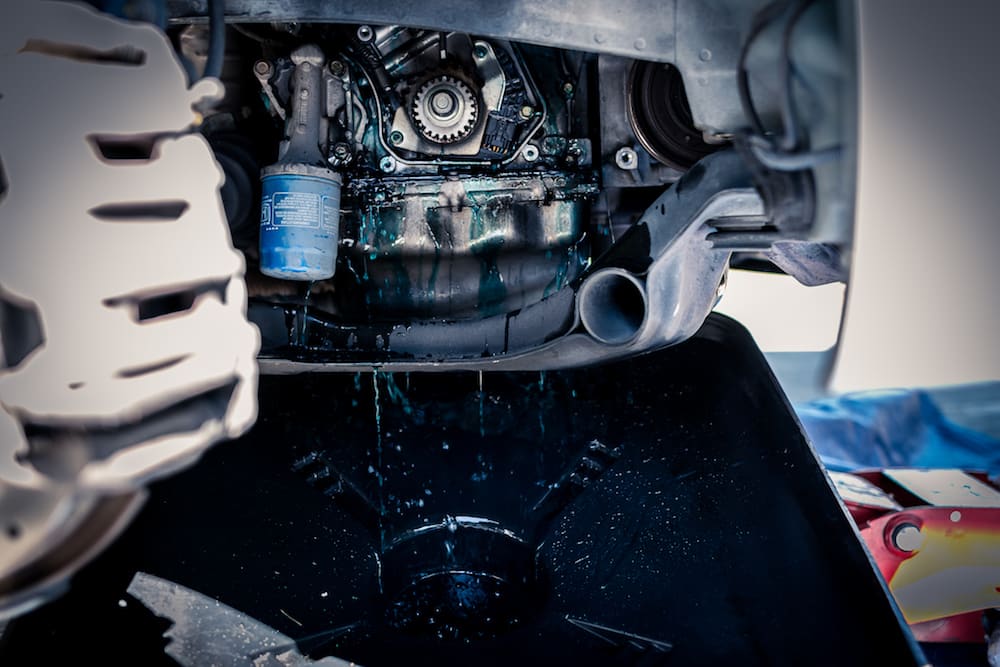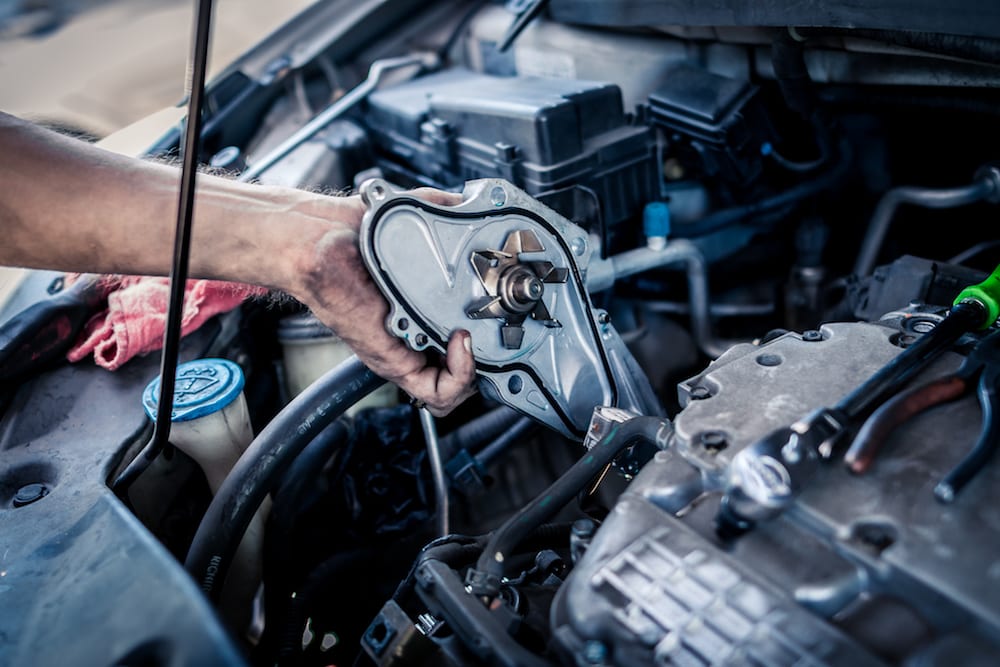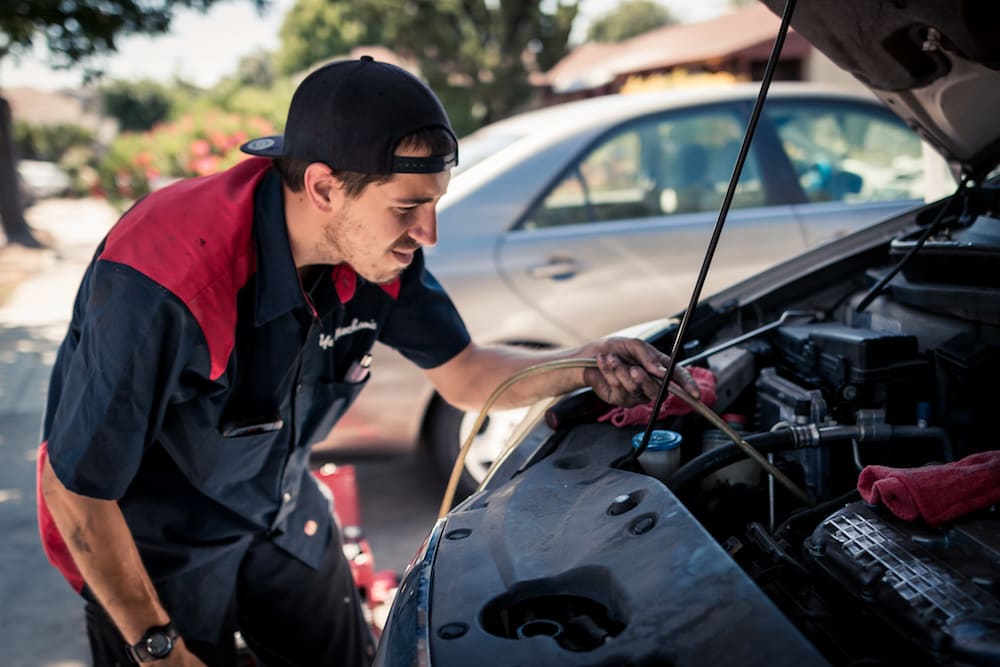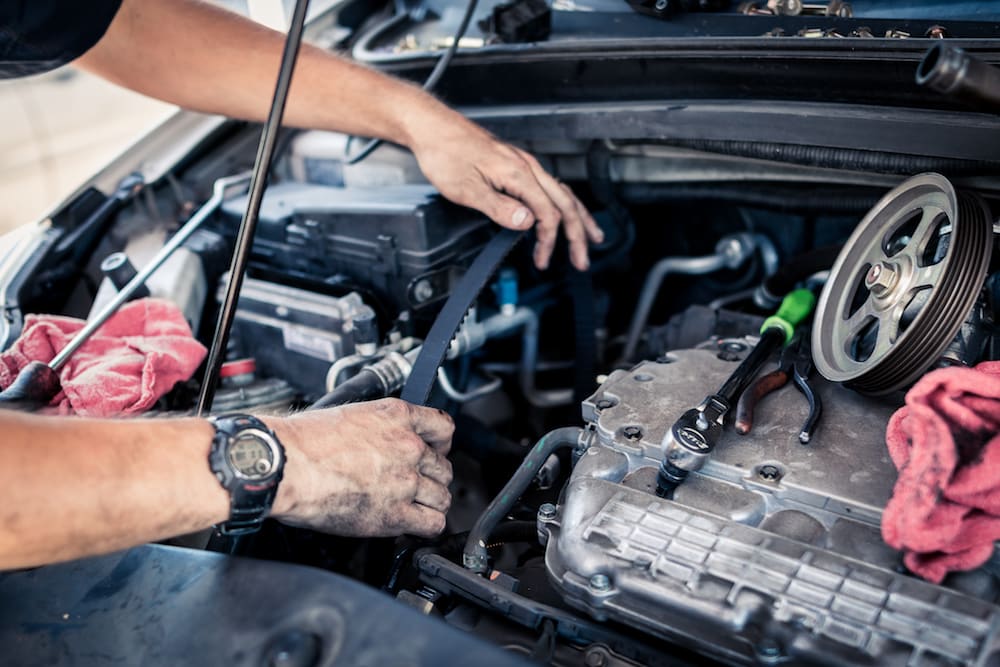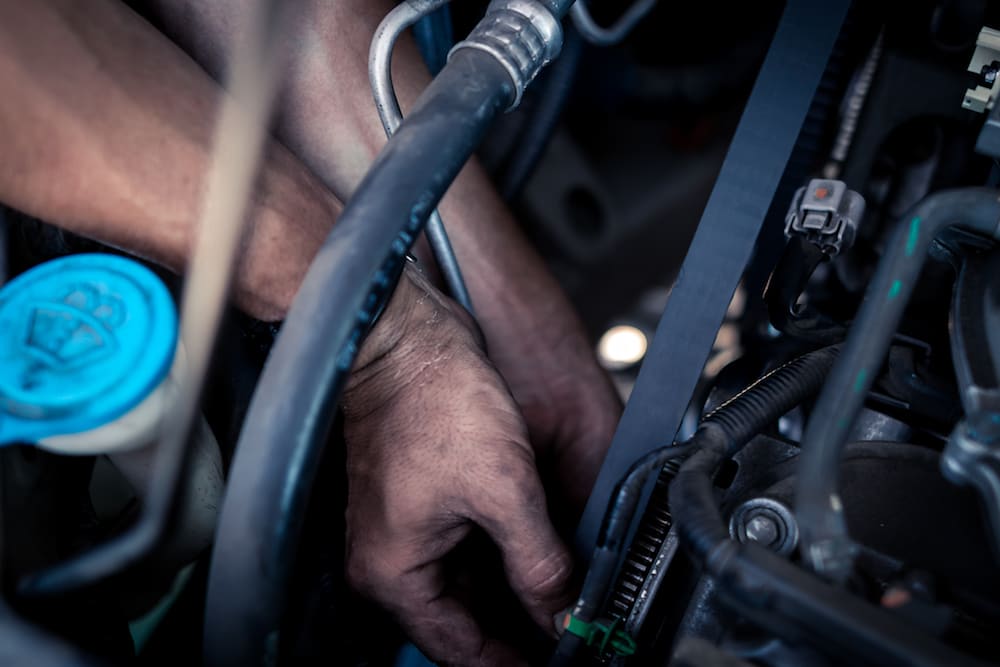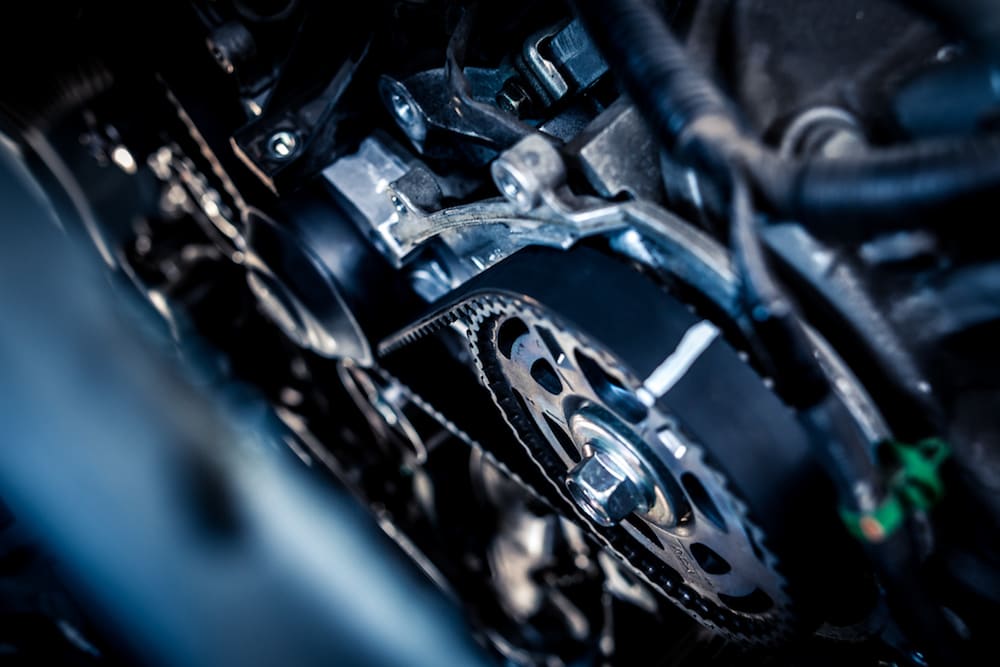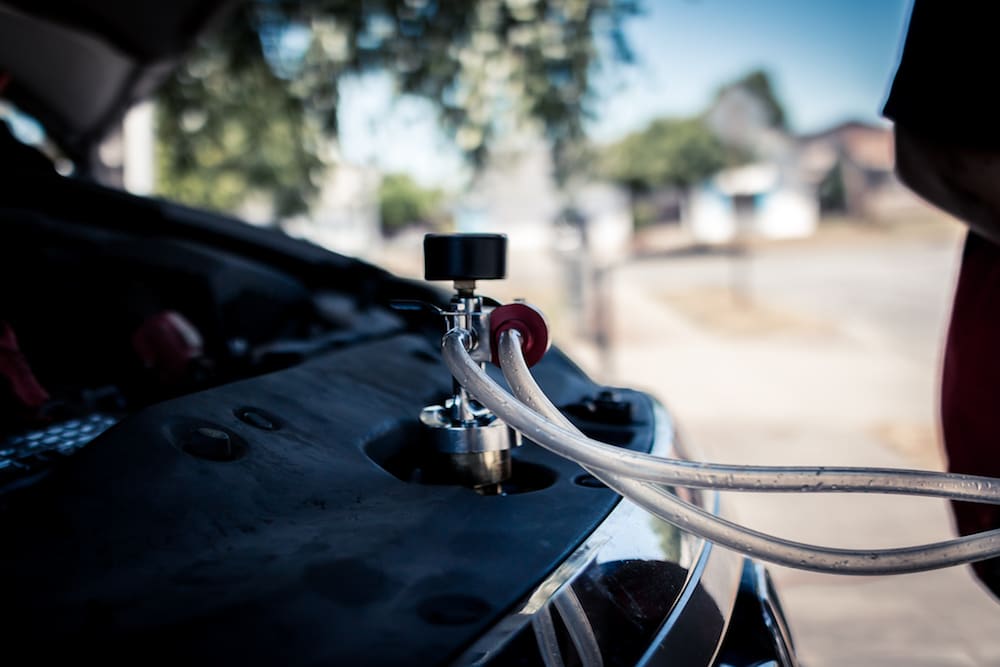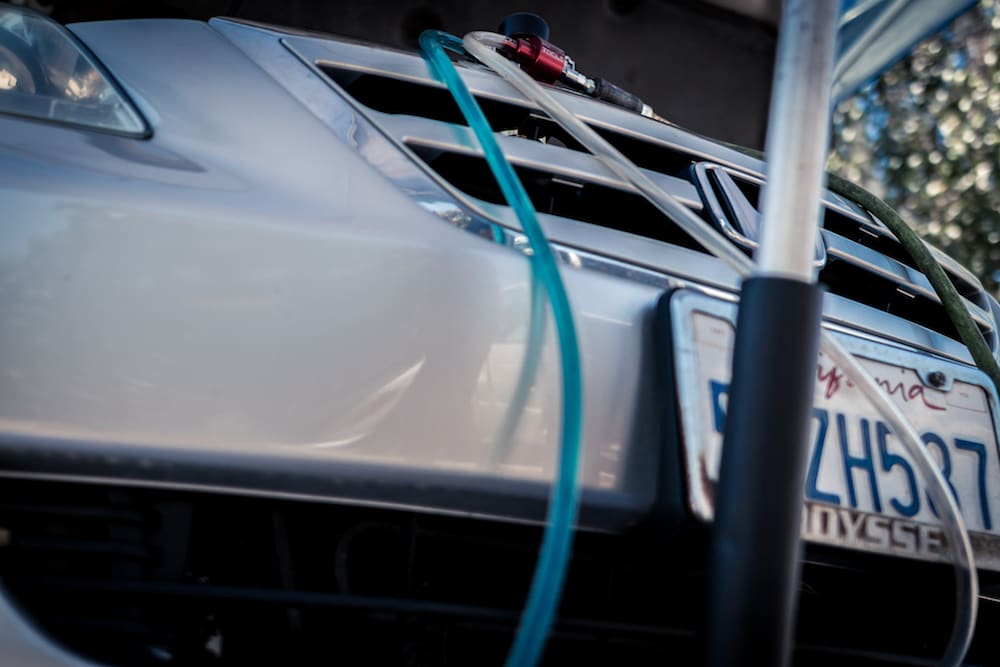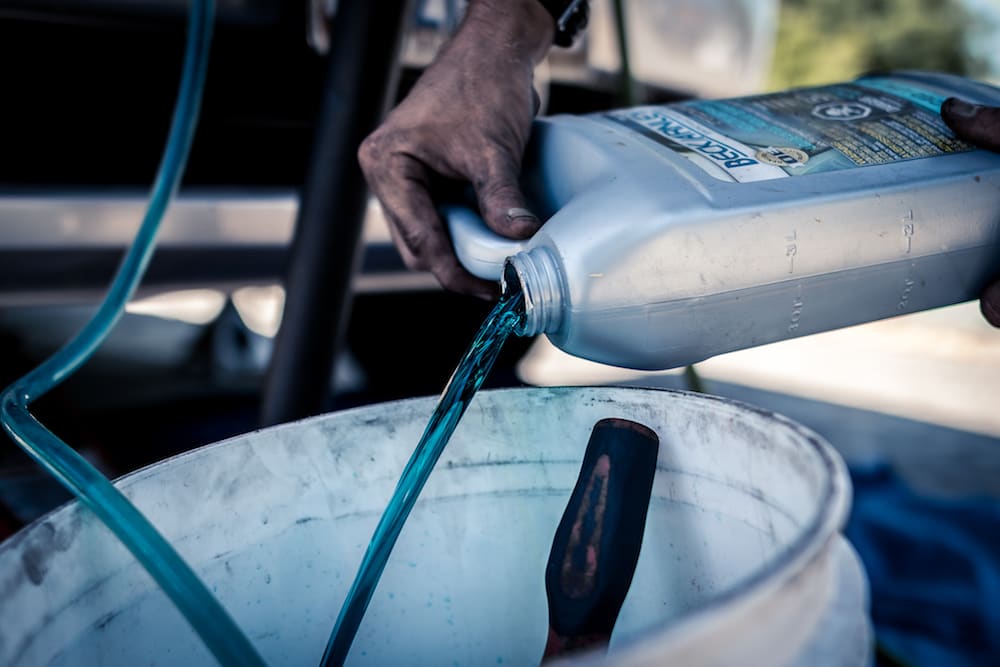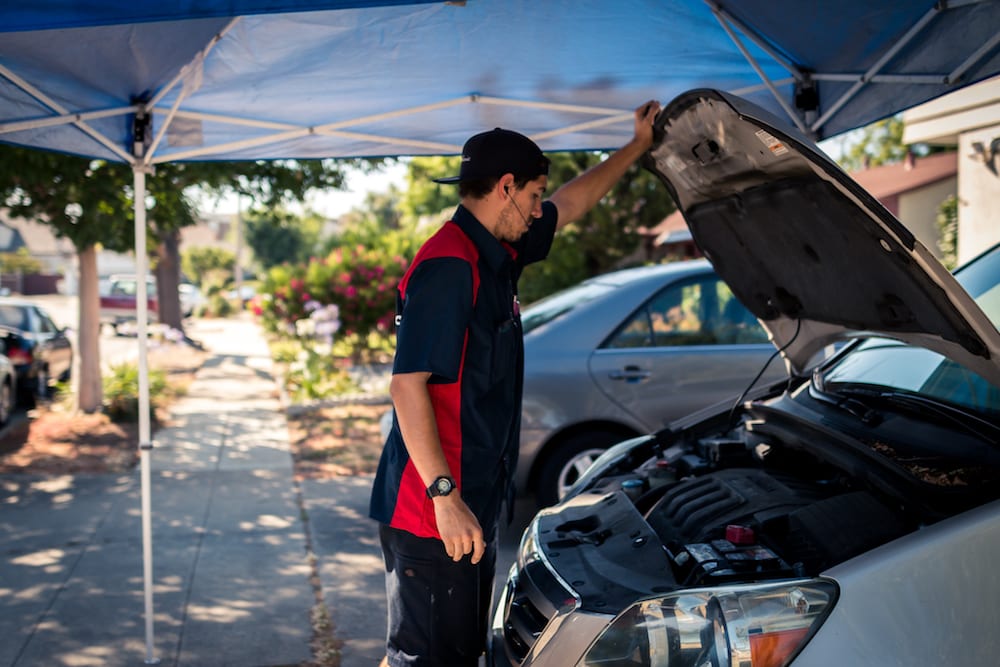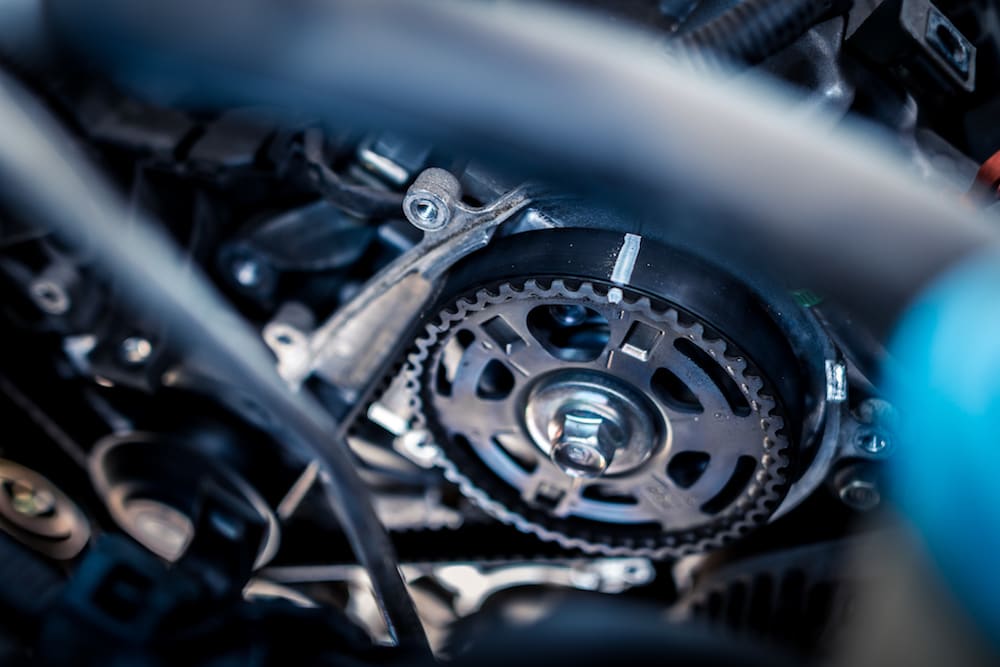

The timing belt is a rubber belt that keeps your camshaft and your crankshaft synchronized so that the valve timing is always right. If your valve timing is off, your engine won’t run properly. In fact, it may not run at all. The timing belt also regulates the power steering and the water pump.
If your car is not starting, and you suspect the timing belt, the first thing you could do is to inspect the belt. If you notice a problem with the timing belt, you may need to replace it entirely.
Part 1 of 3: Prepare to start work on the timing belt
Once you have the keys to the vehicle you can start setting up and preparing to work on the timing belt.
Step 1: Set up the work area. First, set up the 10x10 EZ UP tent if you need it. Then set up an extension cord so that you can get the air compressor filling up.
Next, lay out all your tools and equipment, including the following materials.
Materials Needed
- Box of raven gloves
- Couple of cans of brake clean
- Drain pan for coolant
- Floor jack
- Hose clamps
- Jack stands
- Main toolbox
- Mityvac evacuator
- Miscellaneous hand tools
- New timing belt
- O-ring lubricant
- Piece of wood
- Power tools ( including ½ drive electric impact, ⅜ and ¼ electric ratchets, ⅜ mini impact, ¾ drive impact, air filler gauge for tires, and coolant vacuum filler)
- Reel of air hose
- Tarp to lay under the car
- Threadlocker
- Torque wrench
Step 2: Lay out the new parts. Start laying out the new replacement parts and check to make sure everything is correct.
Step 3: Raise the vehicle using a jack. When doing a timing belt, especially on a front-wheel drive vehicle, always get the car on jack stands and at a decent height. You will need to go between the bottom and top of the vehicle often so this will give you lots of room to work.
Step 4: Lay out the tarp and drain pan. Once the car is on jack stands, lay down the tarp to catch any coolant that you may miss when breaking the water pump lose.
Lay the drain pan on the ground below the radiator and loosen the drain plug on the bottom of the radiator. On most newer cars these are made of plastic, so be careful and try not to break it or damage it in any way.
Step 5: Let the coolant drain out. Once the drain plug is loose and flowing into the drain pan, open the radiator cap to allow air to escape and let it drain faster.
Step 6: Remove the engine cover. Remove the engine cover and start a pile of old parts. Try to keep the old parts in the order in which you remove them as it makes putting things back together much easier.
Step 7: Remove the front passenger-side wheel. Next, take off the passenger front wheel and set it aside.
While most cars will have a plastic cover behind the wheel that will need to come off as well, your vehicle may not have one.
Step 8: Remove the serpentine belt. Use a hefty breaker bar or ratchet to get some leverage and push the tensioner away from the belt. Remove the serpentine belt.
Loosen the 2 bolts holding the power steering pump to the block. This step isn't really necessary - technically, you could work around it, but this step makes it much easier to work on your car.
Step 9: Remove the power steering fluid. Use the evacuator to remove the power steering fluid from the reservoir. Then, use two hose clamps to pinch off the power steering return hose and keep air from getting into the power steering pump.
Step 10: Remove the return hose from the reservoir. Loosen the power steering pump bolts completely and remove the return hose from the reservoir. Set aside the whole pump and return hose with clamps.
- Tip: As there will still be a little bit of fluid in the hose, to prevent a mess, lay some shop rags under the reservoir when you separate the hose.
Part 2 of 3: Remove the old timing belt
Step 1: Remove the serpentine belt tensioner. Before you can start removing the timing covers, you will need to take off the serpentine belt tensioner, as it will block a few of the timing cover bolts.
Unscrew the 2 bolts holding it on; the main big bolt that goes through one of the pulleys, and the guide bolt for the tensioner part of the assembly. Remove the tensioner.
Step 2: Remove the timing covers. Once the tensioner is out of the way, remove the 10 bolts holding on the 2 upper timing covers on and pull out the covers, being careful of any parts of the wiring harness that may be attached to the timing covers.
Step 3: Loosen the engine mount bracket bolts. Roll the jack under the car, place a piece of wood on the jack-up point and jack up the engine oil pan by a little bit.
With the engine supported, remove the engine mount and loosen the bolts to the engine mount bracket.
Step 4: Find Top Dead Center or TDC. Use the hefty ratchet with 2 extensions to turn the motor by hand. Always make sure you turn the motor in the same direction it runs.
Step 5: Remove the crankshaft pulley. Once you’ve turned the motor over by hand until the 3 marks are aligned (one on each camshaft sprocket, and the other on the lower timing cover/crank pulley), remove the crankshaft pulley.
- Tip: If your car has extremely tight crank bolts, use an impact gun to break them loose. A ¾ drive air impact gun at 170 psi will break it loose as if it is a lug nut.
Step 6: Remove rest of the timing cover. Remove the last piece of the timing cover by removing the 8 bolts that hold it on. Once removed, it gives you access to the timing components.
Step 7: Put on the crankshaft bolt. Before doing anything else, remove the metal guide off the nose of the crankshaft - it should just slide right off. Then, take the crankshaft bolt and screw it all way back into the crankshaft so that you can turn the motor if you need to.
Step 8: Check the alignment of the timing marks. If breaking the crank bolt loose moved your timing marks at all, make sure you correct them now before removing the belt, as they need to be exactly aligned with each other. Now that the crank pulley and lower timing cover are removed, the mark for the crank is on the timing belt crank sprocket and it lines up with an arrow on the block. That mark needs to be perfectly aligned with the mark on each camshaft sprocket.
- Tip: Use a paint pen and make the marks more visible. Draw a straight line on the belt, so you can see that it is lined up perfectly.
Step 9: Add a bolt on the roller timing belt tensioner. On the roller timing belt tensioner, there is a bolt hole that you can thread a 6mm bolt into (at least 60mm long). Add the bolt and it will push against the roller tensioner to hold its position. This will make pulling the pin easier to do later.
Step 10: Remove the timing belt. Once you have confirmed that all three marks are lined up, it is time to remove the timing belt. To do so, try to remove the guide pulley slowly, as it’s held on by one through bolt.
Once the belt is off, go around and remove the belt from each sprocket/pulley. Then, remove the two bolts holding the hydraulic tensioner on, and the single bolt holding the roller tensioner.
Step 11: Lower the jack. Lower the jack slowly and move it aside. Put a large drain pan under the front of the motor.
Step 12: Remove the water pump. The water pump is held on by 5 bolts. Take out all the bolts but one - loosen the last one halfway, and then just tap the water pump pulley with a rubber mallet or crowbar until it separates from the block and the coolant begins to drain into the pan.
Step 13: Clean the surfaces. Once the block has fully drained, use the evacuator to suck out any coolant that you can see in the water holes on the block.
Take a can of brake cleaner and spray the whole front of the motor so that you can get all that coolant off and clean up any oil residue. Ensure that you clean the sprockets and the water pump mating surface really well. Also, clean up the mating surface of any old O-ring material, or any visible coolant corrosion.
Part 3 of 3: Install the new timing belt
Step 1: Install the new water pump. Once everything is prepped and clean, you can install the new water pump.
- Tip: Take the o-ring and coat it with some o-ring lubricant before seating it in the groove of the water pump, so that it creates a nice seal on the block.
Install the new water pump onto the alignment dowels. Start tightening the 5 bolts in an even sequence and then torque to 100 lbs. Go over them twice, just to make sure they are all torqued correctly.
Step 2: Install the hydraulic tensioner, roller tensioner, and idler. Put a drop of red threadlocker on all the bolts for these parts.
Torque the hydraulic tensioner bolts to 100 lbs and the roller tensioner to 35 ft lbs. You do not need to torque the idler until you put the new timing belt.
Step 3: Install the new timing belt. Start with the crank sprocket and work your way around in a counterclockwise direction, keeping the new timing belt tight as you go. Ensure that the belt sits properly on the teeth of the camshaft and crankshaft sprockets. Make sure the marks on the belt line up with the marks on the sprockets.
After the belt is on, there should be some slack in between the tensioner and the crank sprocket. Once you pull the pin out of the hydraulic tensioner, it will take up that slack and the belt will remain tight all the way around.
Once you pulled the pin in the hydraulic tensioner, remove the bolt that you installed earlier. Now, by hand, turn the motor clockwise 6 times and make sure your marks all line up. As long as they are lined up, you can begin to reinstall the rest of your components in reverse order.
Step 4: Set up the coolant vacuum filter. To use this, you need to have the special tool and radiator adapter fittings. First, tighten the radiator drain plug that you had loosened earlier. Then, install the adapter fitting onto the top of the radiator.
With the fitting installed, install our tool, and route the bleeder hose into the grill, and our filler hose into a clean bucket.
- Tip: Hold down the filler hose with a long screwdriver to make sure it stays at the bottom of the bucket.
Step 5: Add coolant. Put 2 gallons of blue 50/50 coolant into a bucket. Hook up the air hose, turn the valve and allow it to vacuum the cooling system. Get the pressure to about 25-26 hg so that it holds the vacuum upon turning off the valve. This will tell you that there are no leaks in the system. As long as it’s holding pressure, you can turn the other valve to allow the coolant to be pulled into the system.
While the system is filling, you begin to reassemble the parts in the reverse order of how you removed them.
- Note: Remember to put on the engine mount bracket and metal guide before installing the bottom timing cover.
Install the crank pulley and torque to 180 ft lbs.
Step 6: Check the car. Once everything is back together, you can start the vehicle. Get inside your car and turn the heater and fan on full blast. As long as the vehicle is running smoothly, the heater is working, and the temp gauge is down or below the center line on the gauge, you are good to go.
Let the car warm up at idle to operating temperature before you test drive. This gives you a chance to clean up all your tools and the old parts. By the time you are cleaned up, the vehicle is ready to be test driven.
If you'd like a professional technician, such as one from YourMechanic, to replace your timing belt for you, one of our mechanics would be happy to work on your car at your home or office.




